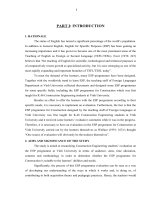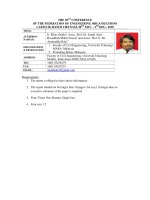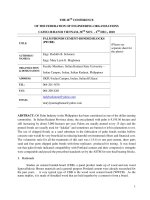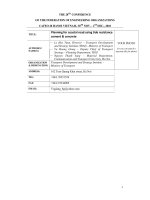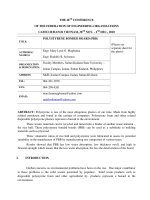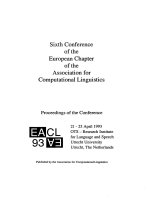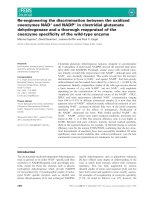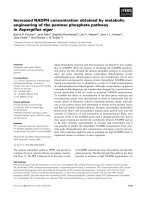THE 28TH CONFERENCE OF THE FEDERATION OF ENGINEERING ORGANIZATIONS
Bạn đang xem bản rút gọn của tài liệu. Xem và tải ngay bản đầy đủ của tài liệu tại đây (132.64 KB, 12 trang )
THE 28
TH
CONFERENCE
OF THE FEDERATION OF ENGINEERING ORGANIZATIONS
CAFEO 28 HANOI VIETNAM, 30
TH
NOV. - 2
ND
DEC., 2010
TITLE:
POLYSTYRENE BONDED BOARD (PBB)
(Please see
separate sheet for
the photo)
AUTHOR(S)’
NAME(S):
Engr. Mary Lynn G. Magbanua
Engr. Rodolfo B. Solomon
ORGANIZATION
& DESIGNATION:
Faculty Members, Sultan Kudarat State University –
Isulan Campus, Isulan, Sultan Kudarat, Philippines
ADDRESS:
SKSU-Isulan Campus, Isulan, Sultan KUdarat
TEL:
064-201-3878
FAX:
064-200-4261
EMAIL:
ABSTRACT: Polystyrene is one of the most ubiquitous plastics of our time. Made from highly
refined petroleum and found in the casings of computers. Polystyrene foam and other related
disposable polystyrene plastics represent a hazard to the environment.
These wastes materials can be recycled and turned into a binder of another waste material –
the rice hull. These polystyrene bonded boards (PBB) can be used as a substitute to building
materials such as plywood.
Three volumetric ratios of rice hull and polystyrene were fabricated to assess its potential
suitability in the manufacture of PBB by manufacturing test composites of various types.
Results showed that PBB has low water absorption, low thickness swell, and high in
flexural strength which means that the less water absorption, the less the deterioration of the board.
I. INTRODUCTION
Global concerns on environmental problems have been on the rise. One major contributor
to these problems is the solid wastes generated by populace. Solid waste products such as
disposable polystyrene foam and other agricultural by- products represent a hazard to the
environment.
Polystyrene is one of the most ubiquitous plastics of our time. Made from highly refined
petroleum and found in the casings of computers, in disposable cutlery, in yogurt containers and
CD jewel cases as well as in countless other applications hundreds of thousands of tons of
polystyrene are produced for our throw-away society
(www.cawrecycles.org/issues/eps_environmental_effects-).
Rice hull is a waste product of rice milling. It is generated during the first stage of milling
when rough rice is husked (Lange, 2000). It comes in great volume and usually considered to
contribute to the environmental problems when dumped or burned (Smajilla, 2000). Latest statistics
show that more than 150 million tons of rice hulls are generated each year worldwide.
Studies show that rice can be useful in the fabrication of boards and other construction
materials because of its high silica components such as lignin, cellulose and hemicellulose (Shieh-
Lieh, 2000), Because of its high fiber, silica and lignin, (Olivier, http://www. Esria.com/pdf/The-
Rice-Hull-House.PDF) rice hull resist fungal decomposition and water penetration and was found
out to have insulating properties.
Agro waste materials are very abundant in Sultan Kudarat. Agro wastes such as rice hulls
and palm fronds abound in the said province. Oil palm fronds fibers are utilized and developed by
converting it to fiber based materials (http//www.aseansec.org /7011html.).
These waste materials can be recycled and turned into a binder of another waste material
which is the rice hull.
Adoption of these materials will be beneficial to the builders. This Polystyrene Bonded
Boards (PBB) can be used as substitute to building materials such as plywood which is cheaper in
the construction industry. This will also help to decrease the continuous rising cost of housing
materials. Also, it will lessen the use of wood that causes widespread deforestation.
The basic aim is to make a polystyrene bonded board (PBB) out of the agro waste materials
commonly found in the locale. It tested the compatibility of the polystyrene binder mix with rice
hull.
The physical property of the board such as density, thickness swelling, and water
absorption at different volumetric ratio was measured. Also the flexural strength of the board at
different volumetric ratio in three were tested using the Universal Testing Machine (UTM) at the
Department of Public Works and Highways Laboratory (DPWH).
II. METHODOLOGY
The materials used in the production of polystyrene bonded boards (PBB) are rice hull,
polystyrene and binder called acrylic thinner.
Polystyrene was collected, cleaned and shredded to the desired size for ease of mixing. A
polymer was mixed to dissolve the polystyrene. The dissolved polystyrene was used as binder for
the rice hull.
Binder Mix
The binder was a mixture of lacquer thinner as dissolving agent and polystyrene using a
60:40, 70:30 and 80:20 for the three (3) mixtures with three replicates for each ratio.
Table 1. Mix proportion of binder and rice hull
ID no. Binder/
Particle
ratio
Binder
(g)
Particle
Rice
hull(g)
PBB
6040
60:40 60 40
PBB
7030
70:30 70 30
PBB
8020
80:20 80 20
The specimens with dimensions of 0.02 cm by 0.15cm. by 0.30cm was cast in mold and
allowed to dry in room temperature for one week. Then it was subjected to curing method.
The F –test was used in finding out if there is a significant difference in terms of flexural
strength. Further, it was tested using the Duncan Multiple Range Test (DMRT).
Melting of Polystyrene
Melted polystyrene used as binder
Mixing of binder and rice hull
The samples
III. RESULTS AND DISCUSSION
The following tables present the results of the compressive tests of the samples from the
Universal Testing Machine (UTM) and the statistical analysis performed on the data gathered. It
also presents the interpretation of the results of the analysis.
Table 2. Water Absorption by Water Immersion Treatment of PBB
Treatment/
Volumetric
Ratio
Replicates
Weight
(g)
Water
Absorption
%
Average
Water
Absorption
(%)
Ww Dw
PBB 60:40
1 15 15.9 0.06
0.08
2 15 17.15 0.14
3 15 15.7 0.05
PBB 70:30
1 35 35.6 0.017
0.023
2 35 35.5 0.014
3 35 36.29 0.037
PBB 80:20
1 25 26.8 0.072
0.045
2 25 25.7 0.028
3 25 25.9 0.036
Results for the water absorption of PBB by soaking are 0.023, 0.045 and 0.08 for
volumetric ratio 70:30, 80:20 and 60:40 respectively. Using the JIS standards for boards which
is <50% all the three treatments revealed a low water absorption; thus passing the JIS 1408
allowable value of <50%.
Table 3. Thickness Swell by Water Immersion Treatment of PBB
Treatment/
Volumetric
Ratio
Replicates
Thickness
mm
Swelling
%
Average
Swell
(%)
Before
Soaking
After
Soaking
